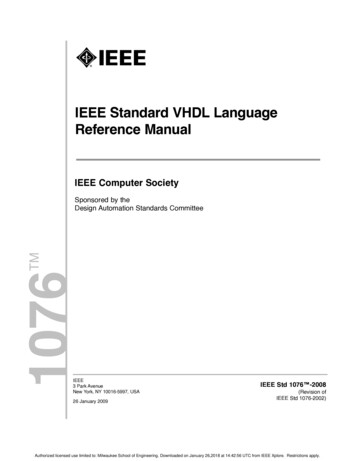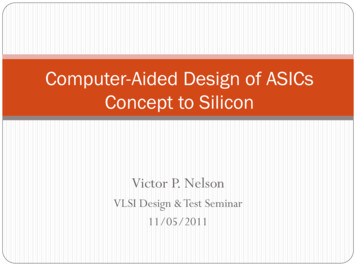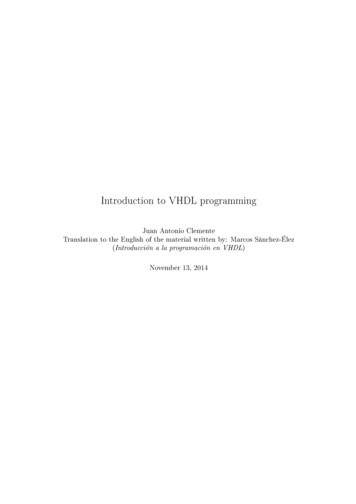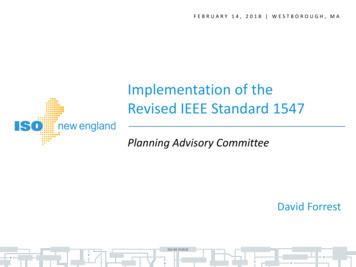
Transcription
IEEE Standard VHDL LanguageReference ManualIEEE Computer Society1076TMSponsored by theDesign Automation Standards CommitteeIEEE3 Park AvenueNew York, NY 10016-5997, USA26 January 2009IEEE Std 1076 -2008(Revision ofIEEE Std 1076-2002)Authorized licensed use limited to: Milwaukee School of Engineering. Downloaded on January 26,2018 at 14:42:56 UTC from IEEE Xplore. Restrictions apply.
Authorized licensed use limited to: Milwaukee School of Engineering. Downloaded on January 26,2018 at 14:42:56 UTC from IEEE Xplore. Restrictions apply.
IEEE Std 1076 -2008(Revision ofIEEE Std 1076-2002) IEEE Standard VHDL LanguageReference ManualSponsorDesign Automation Standards Committee of the IEEE Computer SocietyApproved 26 September 2008 IEEE SA-Standards BoardAuthorized licensed use limited to: Milwaukee School of Engineering. Downloaded on January 26,2018 at 14:42:56 UTC from IEEE Xplore. Restrictions apply.
AcknowledgmentsThe editing and technical work done on the 2008 revision of this standard was done in collaborationbetween Accellera VHDL Technical Subcommittee and the IEEE VHDL Analysis and ScreeningCommittee (VASG). Accellera had donated all of its work and copyrights back to the IEEE.Material in clause titled “Protect Tool Directives” is derived from the document titled “A Mechanishfor VHDL Source Protection” 2004, Cadence Design Systems Inc. Used, modified, and reprintedby permission of Cadence Design Systems Inc.The packages FIXED GENERIC PKG, FIXED PKG, FLOAT GENERIC PKG, FLOAT PKG, andFIXED FLOAT TYPES were modified and used with permission from Eastman Kodak Company 2006. Material in annex clauses titled “Using the fixed-point package” and “Using the floatingpoint package” is derived from the documents titled “Fixed Point Package User’s Guide” and“Floating Point Package User’s Guide” by Eastman Kodak Company 2006. Used, modified, andreprinted by permission of Eastman Kodak Company.The package STD LOGIC TEXTIO was modified and used with permission of Synopsys, Inc. 1990, 1991, and 1992.Abstract: VHSIC Hardware Description Language (VHDL) is defined. VHDL is a formal notationintended for use in all phases of the creation of electronic systems. Because it is both machinereadable and human readable, it supports the development, verification, synthesis, and testing ofhardware designs; the communication of hardware design data; and the maintenance,modification, and procurement of hardware. Its primary audiences are the implementors of toolssupporting the language and the advanced users of the language.Keywords: computer languages, electronic systems, hardware, hardware design, VHDLThe Institute of Electrical and Electronics Engineers, Inc.3 Park Avenue, New York, NY 10016-5997, USACopyright 2009 by the Institute of Electrical and Electronics Engineers, Inc.All rights reserved. Published 26 January 2009. Printed in the United States of America.IEEE and POSIX are registered trademarks in the U.S. Patent & Trademark Office, owned by the Institute of Electrical andElectronics Engineers, Incorporated.MagicDraw and No Magic, Inc., are registered trademarks of No Magic, Inc. in the United States and other countries.TRI-STATE is a registered trademark of National Semiconductor Corporation.2nd Printing 29 July 2011. The following ISBNs were incorrect in the 1st Printing of 26 January 2009.PDF:Print:ISBN 978-0-7381-5800-6ISBN 978-0-7381-5801-3STD95821STDPD95821The correct ISBNs are:PDF:Print:ISBN 978-0-7381-6853-1ISBN 978-0-7381-6854-8STD95821STDPD95821No part of this publication may be reproduced in any form, in an electronic retrieval system or otherwise, without the priorwritten permission of the publisher.Authorized licensed use limited to: Milwaukee School of Engineering. Downloaded on January 26,2018 at 14:42:56 UTC from IEEE Xplore. Restrictions apply.
IEEE Standards documents are developed within the IEEE Societies and the Standards Coordinating Committeesof the IEEE Standards Association (IEEE-SA) Standards Board. The IEEE develops its standards through aconsensus development process, approved by the American National Standards Institute, which brings togethervolunteers representing varied viewpoints and interests to achieve the final product. Volunteers are not necessarilymembers of the Institute and serve without compensation. While the IEEE administers the process and establishesrules to promote fairness in the consensus development process, the IEEE does not independently evaluate, test, orverify the accuracy of any of the information or the soundness of any judgments contained in its standards.Use of an IEEE Standard is wholly voluntary. The IEEE disclaims liability for any personal injury, property or otherdamage, of any nature whatsoever, whether special, indirect, consequential, or compensatory, directly or indirectlyresulting from the publication, use of, or reliance upon this, or any other IEEE Standard document.The IEEE does not warrant or represent the accuracy or content of the material contained herein, and expresslydisclaims any express or implied warranty, including any implied warranty of merchantability or fitness for aspecific purpose, or that the use of the material contained herein is free from patent infringement. IEEE Standardsdocuments are supplied “AS IS.” The existence of an IEEE Standard does not imply that there are no other ways to produce, test, measure, purchase,market, or provide other goods and services related to the scope of the IEEE Standard. Furthermore, the viewpointexpressed at the time a standard is approved and issued is subject to change brought about through developments inthe state of the art and comments received from users of the standard. Every IEEE Standard is subjected to review atleast every five years for revision or reaffirmation. When a document is more than five years old and has not beenreaffirmed, it is reasonable to conclude that its contents, although still of some value, do not wholly reflect thepresent state of the art. Users are cautioned to check to determine that they have the latest edition of any IEEEStandard.In publishing and making this document available, the IEEE is not suggesting or rendering professional or otherservices for, or on behalf of, any person or entity. Nor is the IEEE undertaking to perform any duty owed by anyother person or entity to another. Any person utilizing this, and any other IEEE Standards document, should relyupon his or her independent judgment in the exercise of reasonable care in any given circumstances or, asappropriate, seek the advice of a competent professional in determining the appropriateness of a given IEEEstandard.Interpretations: Occasionally questions may arise regarding the meaning of portions of standards as they relate tospecific applications. When the need for interpretations is brought to the attention of IEEE, the Institute will initiateaction to prepare appropriate responses. Since IEEE Standards represent a consensus of concerned interests, it isimportant to ensure that any interpretation has also received the concurrence of a balance of interests. For this reason,IEEE and the members of its societies and Standards Coordinating Committees are not able to provide an instantresponse to interpretation requests except in those cases where the matter has previously received formalconsideration. At lectures, symposia, seminars, or educational courses, an individual presenting information on IEEEstandards shall make it clear that his or her views should be considered the personal views of that individual ratherthan the formal position, explanation, or interpretation of the IEEE.Comments for revision of IEEE Standards are welcome from any interested party, regardless of membershipaffiliation with IEEE. Suggestions for changes in documents should be in the form of a proposed change of text,together with appropriate supporting comments. Comments on standards and requests for interpretations should beaddressed to:Secretary, IEEE-SA Standards Board 445 Hoes Lane Piscataway, NJ 08854 USAAuthorization to photocopy portions of any individual standard for internal or personal use is granted by the Instituteof Electrical and Electronics Engineers, Inc., provided that the appropriate fee is paid to Copyright Clearance Center.To arrange for payment of licensing fee, please contact Copyright Clearance Center, Customer Service, 222Rosewood Drive, Danvers, MA 01923 USA; 1 978 750 8400. Permission to photocopy portions of any individualstandard for educational classroom use can also be obtained through the Copyright Clearance Center.Authorized licensed use limited to: Milwaukee School of Engineering. Downloaded on January 26,2018 at 14:42:56 UTC from IEEE Xplore. Restrictions apply.
IntroductionThis introduction is not part of IEEE Std 1076-2008, IEEE Standard VHDL Language Reference Manual.The VHSIC Hardware Description Language (VHDL) is a formal notation intended for use in all phases ofthe creation of electronic systems. Because it is both machine readable and human readable, it supports thedevelopment, verification, synthesis, and testing of hardware designs; the communication of hardwaredesign data; and the maintenance, modification, and procurement of hardware.This document, IEEE Std 1076-2008, is a revision of IEEE Std 1076-2002 as amended byIEEE Std 1076cTM-2007. Initial work on gathering requirements and developing language extensionswas undertaken by the IEEE VHDL Analysis and Standardization Group (VASG), otherwise known as the1076 Working Group. Subsequently, Accelleraa sponsored an effort to complete that work and draft arevised Language Reference Manual. That draft was returned to IEEE for final revision and approval,resulting in this document and the associated machine-readable files. This revision incorporates numerousenhancements, both major and minor, to previously existing language feaures and several new languagefeatures. The changes are summarized in Annex E. In addition, several VHDL library packages that werepreviously defined in separate standards are now defined in this standard, ensuring that they are treated asintegral parts of the language. Finally, this revision incorporates the IEEE Property Specification Language(PSL) as part of VHDL. The combination of these changes significantly improves VHDL as a language forspecification, design, and verification of complex electronic systems.The maintenance of the VHDL language standard is an ongoing process. The chair of the VHDL Analysisand Standardization Group extends his gratitude to all who have participated in this revision, both in theIEEE committees and the Accellera effort, and encourages the participation of all interested parties in futurelanguage revisions.bNotice to usersLaws and regulationsUsers of these documents should consult all applicable laws and regulations. Compliance with theprovisions of this standard does not imply compliance to any applicable regulatory requirements.Implementers of the standard are responsible for observing or referring to the applicable regulatoryrequirements. IEEE does not, by the publication of its standards, intend to urge action that is not incompliance with applicable laws, and these documents may not be construed as doing so.CopyrightsThis document is copyrighted by the IEEE. It is made available for a wide variety of both public and privateuses. These include both use, by reference, in laws and regulations, and use in private self-regulation,standardization, and the promotion of engineering practices and methods. By making this documentavailable for use and adoption by public authorities and private users, the IEEE does not waive any rights incopyright to this document.aMore information is available at www.accellera.org.If interested in participating, please contact the VASG at stds-vasg@ieee.org or visit: http://www.eda.org/vasg.bivCopyright 2009 IEEE. All rights reserved.Authorized licensed use limited to: Milwaukee School of Engineering. Downloaded on January 26,2018 at 14:42:56 UTC from IEEE Xplore. Restrictions apply.
Updating of IEEE documentsUsers of IEEE standards should be aware that these documents may be superseded at any time by theissuance of new editions or may be amended from time to time through the issuance of amendments,corrigenda, or errata. An official IEEE document at any point in time consists of the current edition of thedocument together with any amendments, corrigenda, or errata then in effect. In order to determine whethera given document is the current edition and whether it has been amended through the issuanceof amendments, corrigenda, or errata, visit the IEEE Standards Association website at http://ieeexplore.ieee.org/xpl/standards.jsp, or contact the IEEE at the address listed previously.For more information about the IEEE Standards Association or the IEEE standards development process,visit the IEEE-SA website at http://standards.ieee.org.ErrataErrata, if any, for this and all other standards can be accessed at the following URL: ata/index.html. Users are encouraged to check this URL forerrata periodically.InterpretationsCurrent interpretations can be accessed at the following URL: x.html.PatentsAttention is called to the possibility that implementation of this standard may require use of subject mattercovered by patent rights. By publication of this standard, no position is taken with respect to the existence orvalidity of any patent rights in connection therewith. The IEEE shall not be responsible for identifyingpatents or patent applications for which a license may be required to implement an IEEE standard or forconducting inquiries into the legal validity or scope of those patents that are brought to its attention.ParticipantsAt the time this standard was submitted to the IEEE-SA Standards Board for approval, the 1076 WorkingGroup had the following membership:Jim Lewis, ChairChuck Swart, Vice ChairPeter Ashenden, Secretary and Technical EditorJohn AynsleyStephen BaileyVictor BermanPatrick BryantRoland R. HenrieDaniel KhoFrançoise MartinolleCopyright 2009 IEEE. All rights reserved.Egert MolenkampRobert MyersFarrell OstlerJohn RiesTimothy SchneiderSukrit ShankarJohn ShieldsAlain VachouxAjayharsh VarikatRichard WallaceJohn WillisAlex ZamfirescuMark ZwolinskivAuthorized licensed use limited to: Milwaukee School of Engineering. Downloaded on January 26,2018 at 14:42:56 UTC from IEEE Xplore. Restrictions apply.
The following members of the individual balloting committee voted on this standard. Balloters may havevoted for approval, disapproval, or abstention.William HannaM. HashmiWerner HoelzlJoseph HupceyPiotr KarockiKurt KermesJim LewisG. LuriTimothy McBrayerDonald MillsEgbert MolenkampRobert MyersPrajit NairZ. NavabiMichael S. NewmanUlrich PohlPeter AshendenBakul BanerjeeVictor BermanMartin J. BishopLyle BullockJames CaseKeith ChowErnst ChristenS. ClaassenKevin CogginsJoanne DegroatThomas DineenSteven DovichGeorge EconomakosCharles GardinerSergiu GomaRandall GrovesBartien SayogoTimothy SchneiderStephen SchwarmJohn SheppardJohn ShieldsDavid SmithWalter StrupplerChuck SwartLance ThompsonYatin TrivediAlain VachouxAjayharsh VarikatSrinivasa VemuruKathy WernerJohn WillisPaul WorkMark ZwolinskiWhen the IEEE-SA Standards Board approved this standard on 26 September 2008, it had the followingmembership:Robert M. Grow, ChairThomas Prevost, Vice ChairSteve M. Mills, Past ChairJudith Gorman, SecretaryVictor BermanRichard DeBlasioAndy DrozdMark EpsteinAlexander GelmanWilliam R. GoldbachArnold M. GreenspanKenneth S. HanusJim HughesRichard H. HulettYoung Kyun KimJoseph L. Koepfinger*John KulickDavid J. LawGlenn ParsonsRonald C. PetersenChuck PowersNarayanan RamachandranJon Walter RosdahlRobby RobsonAnne-Marie SahazizianMalcolm V. ThadenHoward L. WolfmanDon Wright*Member EmeritusAlso included are the following nonvoting IEEE-SA Standards Board liaisons:Satish K. Aggarwal, NRC RepresentativeMichael Janezic, NIST RepresentativeJennie SteinhagenIEEE Standards Program Manager, Document DevelopmentMichael D. KipnessIEEE Standards Program Manager, Technical Program DevelopmentviCopyright 2009 IEEE. All rights reserved.Authorized licensed use limited to: Milwaukee School of Engineering. Downloaded on January 26,2018 at 14:42:56 UTC from IEEE Xplore. Restrictions apply.
Contents1.Overview of this standard . 11.1 Scope. 11.2 Purpose. 11.3 Structure and terminology of this standard. 22.Normative references . 53.Design entities and configurations. 73.13.23.33.44.General. 7Entity declarations . 7Architecture bodies . 10Configuration declarations. 13Subprograms and packages. 194.1 General. 194.2 Subprogram declarations . 194.3 Subprogram bodies . 234.4 Subprogram instantiation declarations. 264.5 Subprogram overloading. 264.6 Resolution functions . 294.7 Package declarations. 304.8 Package bodies. 314.9 Package instantiation declarations . 334.10 Conformance rules . 345.Types. 355.15.25.35.45.55.65.76.General. 35Scalar types . 36Composite types. 44Access types. 53File types. 55Protected types . 58String representations . 61Declarations . 636.1 General. 636.2 Type declarations . 646.3 Subtype declarations . 646.4 Objects . 666.5 Interface declarations . 736.6 Alias declarations. 896.7 Attribute declarations. 926.8 Component declarations . 936.9 Group template declarations . 936.10 Group declarations . 936.11 PSL clock declarations. 94Copyright 2009 IEEE. All rights reserved.v iiAuthorized licensed use limited to: Milwaukee School of Engineering. Downloaded on January 26,2018 at 14:42:56 UTC from IEEE Xplore. Restrictions apply.
7.Specifications. 957.17.27.37.48.Names . 1078.18.28.38.48.58.68.79.General. 107Simple names . 108Selected names. 108Indexed names . 111Slice names . 112Attribute names. 112External names. 113Expressions . 1179.19.29.39.49.510.General. 95Attribute specification. 95Configuration specification. 98Disconnection specification . 103General. 117Operators. 118Operands . 131Static expressions. 139Universal expressions . 142Sequential statements. 14510.1 General. 14510.2 Wait statement . 14510.3 Assertion statement. 14710.4 Report statement . 14810.5 Signal assignment statement . 14910.6 Variable assignment statement . 16010.7 Procedure call statement . 16310.8 If statement . 16410.9 Case statement . 16410.10Loop statement. 16610.11Next statement . 16710.12Exit statement . 16710.13Return statement . 16810.14Null statement . 16811.Concurrent statements. 16911.1 General. 16911.2 Block statement. 16911.3 Process statement . 17011.4 Concurrent procedure call statements. 17211.5 Concurrent assertion statements . 17311.6 Concurrent signal assignment statements . 17411.7 Component instantiation statements . 17611.8 Generate statements . 182viiiCopyright 2009 IEEE. All rights reserved.Authorized licensed use limited to: Milwaukee School of Engineering. Downloaded on January 26,2018 at 14:42:56 UTC from IEEE Xplore. Restrictions apply.
12.Scope and visibility. 18512.1 Declarative region. 18512.2 Scope of declarations . 18512.3 Visibility . 18712.4 Use clauses. 19112.5 The context of overload resolution . 19213.Design units and their analysis . 19513.1 Design units .
IEEE Std 1076-2002) IEEE Standard VHDL Language Reference Manual IEEE 3 Park Avenue New York, NY 10016-5997, USA 26 January 2009 IEEE Computer Society Sponsored by the Design Automation Standards Committee 1076 TM Authorized licensed use limited to: Milwaukee School of Engineering. Downloaded on January 2










